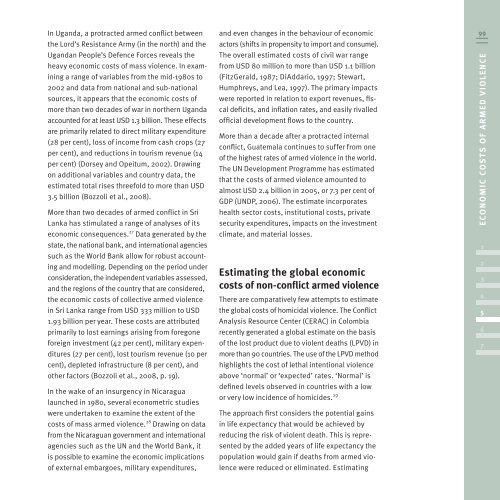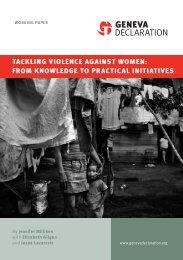Global Burden of Armed Violence - The Geneva Declaration on ...
Global Burden of Armed Violence - The Geneva Declaration on ...
Global Burden of Armed Violence - The Geneva Declaration on ...
You also want an ePaper? Increase the reach of your titles
YUMPU automatically turns print PDFs into web optimized ePapers that Google loves.
In Uganda, a protracted armed c<strong>on</strong>flict between<br />
the Lord’s Resistance Army (in the north) and the<br />
Ugandan People’s Defence Forces reveals the<br />
heavy ec<strong>on</strong>omic costs <str<strong>on</strong>g>of</str<strong>on</strong>g> mass violence. In examining<br />
a range <str<strong>on</strong>g>of</str<strong>on</strong>g> variables from the mid-1980s to<br />
2002 and data from nati<strong>on</strong>al and sub-nati<strong>on</strong>al<br />
sources, it appears that the ec<strong>on</strong>omic costs <str<strong>on</strong>g>of</str<strong>on</strong>g><br />
more than two decades <str<strong>on</strong>g>of</str<strong>on</strong>g> war in northern Uganda<br />
accounted for at least USD 1.3 billi<strong>on</strong>. <str<strong>on</strong>g>The</str<strong>on</strong>g>se effects<br />
are primarily related to direct military expenditure<br />
(28 per cent), loss <str<strong>on</strong>g>of</str<strong>on</strong>g> income from cash crops (27<br />
per cent), and reducti<strong>on</strong>s in tourism revenue (14<br />
per cent) (Dorsey and Opeitum, 2002). Drawing<br />
<strong>on</strong> additi<strong>on</strong>al variables and country data, the<br />
estimated total rises threefold to more than USD<br />
3.5 billi<strong>on</strong> (Bozzoli et al., 2008).<br />
More than two decades <str<strong>on</strong>g>of</str<strong>on</strong>g> armed c<strong>on</strong>flict in Sri<br />
Lanka has stimulated a range <str<strong>on</strong>g>of</str<strong>on</strong>g> analyses <str<strong>on</strong>g>of</str<strong>on</strong>g> its<br />
ec<strong>on</strong>omic c<strong>on</strong>sequences. 27 Data generated by the<br />
state, the nati<strong>on</strong>al bank, and internati<strong>on</strong>al agencies<br />
such as the World Bank allow for robust accounting<br />
and modelling. Depending <strong>on</strong> the period under<br />
c<strong>on</strong>siderati<strong>on</strong>, the independent variables assessed,<br />
and the regi<strong>on</strong>s <str<strong>on</strong>g>of</str<strong>on</strong>g> the country that are c<strong>on</strong>sidered,<br />
the ec<strong>on</strong>omic costs <str<strong>on</strong>g>of</str<strong>on</strong>g> collective armed violence<br />
in Sri Lanka range from USD 333 milli<strong>on</strong> to USD<br />
1.93 billi<strong>on</strong> per year. <str<strong>on</strong>g>The</str<strong>on</strong>g>se costs are attributed<br />
primarily to lost earnings arising from foreg<strong>on</strong>e<br />
foreign investment (42 per cent), military expenditures<br />
(27 per cent), lost tourism revenue (10 per<br />
cent), depleted infrastructure (8 per cent), and<br />
other factors (Bozzoli et al., 2008, p. 19).<br />
In the wake <str<strong>on</strong>g>of</str<strong>on</strong>g> an insurgency in Nicaragua<br />
launched in 1980, several ec<strong>on</strong>ometric studies<br />
were under taken to examine the extent <str<strong>on</strong>g>of</str<strong>on</strong>g> the<br />
costs <str<strong>on</strong>g>of</str<strong>on</strong>g> mass armed violence. 28 Drawing <strong>on</strong> data<br />
from the Nicaraguan government and internati<strong>on</strong>al<br />
agencies such as the UN and the World Bank, it<br />
is possible to examine the ec<strong>on</strong>omic implicati<strong>on</strong>s<br />
<str<strong>on</strong>g>of</str<strong>on</strong>g> external embargoes, military expenditures,<br />
and even changes in the behaviour <str<strong>on</strong>g>of</str<strong>on</strong>g> ec<strong>on</strong>omic<br />
actors (shifts in propensity to import and c<strong>on</strong>sume).<br />
<str<strong>on</strong>g>The</str<strong>on</strong>g> overall estimated costs <str<strong>on</strong>g>of</str<strong>on</strong>g> civil war range<br />
from USD 80 milli<strong>on</strong> to more than USD 1.1 billi<strong>on</strong><br />
(FitzGerald, 1987; DiAddario, 1997; Stewart,<br />
Humphreys, and Lea, 1997). <str<strong>on</strong>g>The</str<strong>on</strong>g> primary impacts<br />
were reported in relati<strong>on</strong> to export revenues, fiscal<br />
deficits, and inflati<strong>on</strong> rates, and easily rivalled<br />
<str<strong>on</strong>g>of</str<strong>on</strong>g>ficial development flows to the country.<br />
More than a decade after a protracted internal<br />
c<strong>on</strong>flict, Guatemala c<strong>on</strong>tinues to suffer from <strong>on</strong>e<br />
<str<strong>on</strong>g>of</str<strong>on</strong>g> the highest rates <str<strong>on</strong>g>of</str<strong>on</strong>g> armed violence in the world.<br />
<str<strong>on</strong>g>The</str<strong>on</strong>g> UN Development Programme has estimated<br />
that the costs <str<strong>on</strong>g>of</str<strong>on</strong>g> armed violence amounted to<br />
almost USD 2.4 billi<strong>on</strong> in 2005, or 7.3 per cent <str<strong>on</strong>g>of</str<strong>on</strong>g><br />
GDP (UNDP, 2006). <str<strong>on</strong>g>The</str<strong>on</strong>g> estimate incorporates<br />
health sector costs, instituti<strong>on</strong>al costs, private<br />
security expenditures, impacts <strong>on</strong> the investment<br />
climate, and material losses.<br />
Estimating the global ec<strong>on</strong>omic<br />
costs <str<strong>on</strong>g>of</str<strong>on</strong>g> n<strong>on</strong>-c<strong>on</strong>flict armed violence<br />
<str<strong>on</strong>g>The</str<strong>on</strong>g>re are comparatively few attempts to estimate<br />
the global costs <str<strong>on</strong>g>of</str<strong>on</strong>g> homicidal violence. <str<strong>on</strong>g>The</str<strong>on</strong>g> C<strong>on</strong>flict<br />
Analysis Resource Center (CERAC) in Colombia<br />
recently generated a global estimate <strong>on</strong> the basis<br />
<str<strong>on</strong>g>of</str<strong>on</strong>g> the lost product due to violent deaths (LPVD) in<br />
more than 90 countries. <str<strong>on</strong>g>The</str<strong>on</strong>g> use <str<strong>on</strong>g>of</str<strong>on</strong>g> the LPVD method<br />
highlights the cost <str<strong>on</strong>g>of</str<strong>on</strong>g> lethal intenti<strong>on</strong>al violence<br />
above ‘normal’ or ‘expected’ rates. ‘Normal’ is<br />
defined levels observed in countries with a low<br />
or very low incidence <str<strong>on</strong>g>of</str<strong>on</strong>g> homicides. 29<br />
<str<strong>on</strong>g>The</str<strong>on</strong>g> approach first c<strong>on</strong>siders the potential gains<br />
in life expectancy that would be achieved by<br />
reducing the risk <str<strong>on</strong>g>of</str<strong>on</strong>g> violent death. This is represented<br />
by the added years <str<strong>on</strong>g>of</str<strong>on</strong>g> life expectancy the<br />
populati<strong>on</strong> would gain if deaths from armed violence<br />
were reduced or eliminated. Estimating<br />
99<br />
ECO N OMIC COS T S OF A R M E D V I O L E N C E<br />
1<br />
2<br />
3<br />
4<br />
5<br />
6<br />
7









